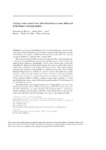Artery/Vein Vessel Tree Identification in Near-Infrared Reflectance Retinographies

Use this link to cite
http://hdl.handle.net/2183/34468Collections
- Investigación (FIC) [1678]
Metadata
Show full item recordTitle
Artery/Vein Vessel Tree Identification in Near-Infrared Reflectance RetinographiesDate
2019-05-29Citation
de Moura, J., Novo, J., Rouco, J. et al. Artery/Vein Vessel Tree Identification in Near-Infrared Reflectance Retinographies. J Digit Imaging 32, 947–962 (2019). https://doi.org/10.1007/s10278-019-00235-x
Is version of
https://doi.org/10.1007/s10278-019-00235-x
Abstract
[Abstract]: An accurate identification of the retinal arteries and veins is a relevant issue in the development of automatic computer-aided diagnosis systems that facilitate the analysis of different relevant diseases that affect the vascular system as diabetes or hypertension, among others. The proposed method offers a complete analysis of the retinal vascular tree structure by its identification and posterior classification into arteries and veins using optical coherence tomography (OCT) scans. These scans include the near-infrared reflectance retinography images, the ones we used in this work, in combination with the corresponding histological sections. The method, firstly, segments the vessel tree and identifies its characteristic points. Then, Global Intensity-Based Features (GIBS) are used to measure the differences in the intensity profiles between arteries and veins. A k-means clustering classifier employs these features to evaluate the potential of artery/vein identification of the proposed method. Finally, a post-processing stage is applied to correct misclassifications using context information and maximize the performance of the classification process. The methodology was validated using an OCT image dataset retrieved from 46 different patients, where 2,392 vessel segments and 97,294 vessel points were manually labeled by an expert clinician. The method achieved satisfactory results, reaching a best accuracy of 93.35% in the identification of arteries and veins, being the first proposal that faces this issue in this image modality.
Keywords
Computer-aided diagnosis
Retinal image analysis
Vasculature
Artery/vein classification
Optical coherence tomography
Retinal image analysis
Vasculature
Artery/vein classification
Optical coherence tomography
Description
This version of the article has been accepted for publication, after peer review and is subject to Springer Nature’s AM terms of use, but is
not the Version of Record and does not reflect post-acceptance improvements, or any corrections. The Version of Record is available
online at: https://doi.org/10.1007/s10278-019-00235-x
Editor version
Rights
Todos os dereitos reservados. All rights reserved.
ISSN
0897-1889





